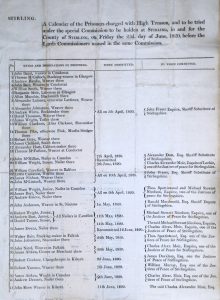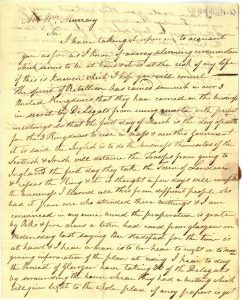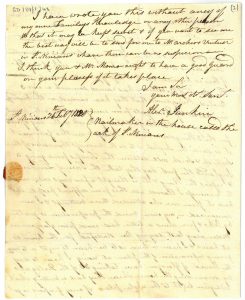In the papers of the Murray family of Polmaise and Touchadam held at the Council Archives, there are a series of letters that relate to the April 1820 uprising of weavers and other workers in defence of better pay and increased enfranchisement. William Murray was an army Major and in charge of troops stationed locally, consequently, the military forces who were ordered to deal with the disturbances arising from the attempted revolt wrote to him constantly. We are fortunate that these letters survive amongst the family papers.
Starting today, we are going to be blogging these letters on the anniversary of their composition to give some idea of the activities in the local area at this time and the response of the authorities to this. What we are hearing here are the voices of soldiers who are very much loyal to the Crown and the Establishment. Unfortunately, we have no records dating from this time that give us an insight into how the men and women from working families locally were feeling during the very tense situation that was prevalent in April 1820.
It may be helpful to provide some background to the events of this time. By 1820, reformist fervour was high in Scotland. Radical ideas had remained in abeyance through the period of the Napoleonic wars. However, after the end of the conflict in 1815, Britain experienced an economic downturn that served to generate renewed interest in reform. In the first decade of the 19th century, the average wage of a weaver in Scotland was halved and continued to fall after this. Weavers, particularly in Scotland, were skilled craftsmen, literate, informed and radical in their outlook. In 1813, in protest at their reduced standard of living, 40,000 weavers went on strike for over two months, a dispute that only ended when the government arrested the leaders of their union and forced the men back to work. News of the slaughter of radical protesters demonstrating in Manchester in 1819, an event that came to be known as the Peterloo Massacre, caused consternation amongst reformists across Britain. Meanwhile, concern was also growing within the Establishment at increasing demands for reform from workers in many occupations. With the horrors of the French revolution very much in mind, the Government was nervous of potential dissent and prepared to employ its spies and agents provocateurs to quash any revolutionary activities amongst the populace. This was the background to the events of 1820.
Rumours of unrest amongst the population in the Stirling area were already circulating in the early part of the year. A letter was written to William Murray of Polmaise and Touchadam, a prominent local landowner whose family papers are held at Stirling Council Archives, on the 26th February by Alexander Junkin, a Nailmaker in St Ninians warning of potential insurrection:
“…a very alarming circumstance which seems to be at hand & it is at the risk of my life if this is known which I hope you will conciel. The spirit of Rebellion has rained so much in owr 3 United Kingdoms that they have carried on the business in secret by Delegats from every quarter… the first day of March is the day…for the 3 Kingdoms to rise in mass and overthro Government…”
In Glasgow, the local unions had formed a covert ‘Committee For Organising a Provisional Government’ and this Committee was organising opposition to the government and using ex-soldiers such as John Baird, a weaver from Condorrat, to train willing men how to fight. Government spies had already infiltrated this movement by 1820 and a meeting of the Committee at Marshall’s Tavern, Gallowgate, Glasgow, on the 21st March was betrayed to the authorities by one John King, a weaver from Anderston. The Committee was surprised, arrested and detained in secret. So successful was this move that none of the radical associates of the men involved were aware of what had happened.
It is widely agreed by historians that the uprising that followed this was engineered by the authorities to encourage those who were prepared to respond to a call to arms to show themselves so that they could be apprehended and dealt with. The men who instigated the organisation of the events of April 1820, John King, a weaver, Duncan Turner, a tinsmith and Robert Lees, known as ‘The Englishman’ are now regarded as having been working for the government; although they were instrumental in the organisation of what happened, they disappeared after the event and were not tried for their part in it. There is no doubt that the unrest throughout Scotland and the north of England at this time issued from real grievances and a desire for change, it was as a response to these that the authorities sought to entrap men such as Baird and Hardie and this sealed their fate.


